Colour Spectrum Notes (avec Panography)
Posted: June 8th, 2009 | Author: lucasmichaelihlein | Filed under: Day 5 | 5 Comments »At this time of life whatever being there is is doing a lot of listening, as though to the feeling of the wind before it starts, and it slides down this anticipation of itself, already full-fledged, a lightning existence that has come into our own. The trees and the streets are there merely to divide it up, to prevent it from getting all over itself, from retreating into itself instead of logically unshuffling into this morning that had to be, of the day of temptation. It is with some playfulness that we actually sit down to the business of mastering the many pauses and the abrupt, sharp accretions of regular being in the clotted sphere of today’s activities. As though this were just any old day. There is no need for setting out, to advertise one’s destination. All the facts are here and it remains only to use them in the right combination, but that building will be the size of today, the rooms habitable and leading into one another in a lasting sequence, eternal and of the greatest timeliness.
John Ashbery, The System.
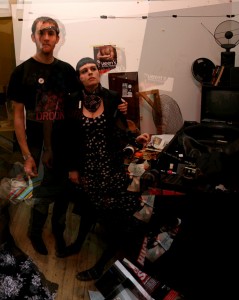
I had arranged to meet my parents at Push and Pull sometime in the late afternoon. Now sometime in the late afternoon is a pretty open temporal window when it comes to meeting someone, so it was quite funny when we both arrived at Locksmith within 30 seconds of each other. It’s seems probable that this is how the whole arriving on time thing works, that is, when you arrange a rigid time you are mostly late and occasionally early but never on time, and when you arrange an open time so nobody is late or early then you both arrive at exactly the same time. Amy Harper – who had donated the puzzle for the opening night – arrived at this time, and her partner Pat Armstrong – who designed the poster – would also have arrived at this time if it weren’t for his habit of chronically under-estimating how long it takes him to get anywhere. So it was a time of arrivals, and as though to balance things out, of departures too (Will first, and then Zoë). Joel and I were in our usual after-soccer state of starvation so the first thing we did was get a plate from the kitchen, plonk ourselves in opposite corners of the room and shovel the Indonesian food in as fast as possible. I’m pretty sure Joel did not utter a single word during this time.
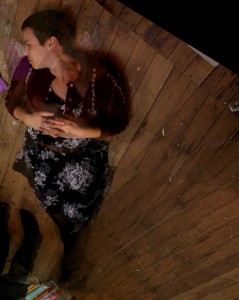
Mum had been reading up on the website, so her and Dad came armed with some notion of what the work was and weren’t at all uncomfortable with the lack of any clearly defined thing to see. The dominant pattern of their lives is Mum having to talk Dad into doing something, and the first something she talked him into doing at Push and Pull was to play a game of foosball. They were soon joined by Kenzee and Kenzie, and the stakes of the game were immediately raised, literally, since at some point it was decided that the table needed to be higher off the ground. So the table was propped up on four chairs, the lower backs of the young and old were not under so much stress and there was an even more pronounced slope to the table. In fact it was really two games in one, with Kenzee and Kenzie being direct opponents and monopolising the play between them, while Mum and Dad were not so much directly opposing one another as playing a game of mutual exclusion. Having said that Dad managed to win the game with a length-of-the-field wondergoal from the boot of the right full back. At some point during the game Pat did finally arrive and we greeted by attacking each others face with 1 pixel width photoshop lines. He had brought a whole bunch of goodies, including string and cable ties, and so he got to work stringing up the room while Amy sat on the couch attaching mouse traps to the bike wheel. Next to her Anneke sat and wrote into her notebook while Smith occupied himself with the fairy tales book by cutting out animals he secretly wishes he could be. Joel and I finished eating around the time the foosball ended and Mum started agitating for some push pull. One of the things I like best about my Mum is her desire to be active and involved, and so it was at her direction that the foosball moved from the centre to periphery and was replaced with the massage table. As I found out by forensically studying the timelapse from the opening night, the massage table entered the space in tact only to have one half of the foam cut out of it by Kenzie Larsen and put on the head of Trevor Fry! The consequence of this was that the space where you put your head was ringed with tiny nails, indeed there were whole sets of tiny nails spiking out from the wood. So Mum and I had to use the blue pillow (which I recall Lucas describing as urine soaked) and the saturday Herald (that undead paper) to cover the nails so the table could be laid on.
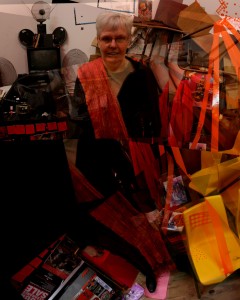
One of the prevalent aspects of Push & Pull – or which Push & Pull has drawn attention to – is non-conventional experimentation with objects. Many people, in fact most people, have responded to the space by imaging possibilities for the objects other than their typical use, to see what objects might become when liberated from their strictly functional selves. We are, after all, homo ludens – creatures that play – and objects are not simply dumb things out there in concrete reality, they are objects of experience, as Astrid says in her essay, they are quasi-objects, active through engagement and movement, with sensual, textual, material and psychological qualities that are all part of their objecthood. An obvious example of this is the chair–creature, using school chairs, tapes, combs and knives as body parts of a creature, that is, to make something both object and animal at once and thus produce totemic power. Another example of this is two things that Sarah Goffman did, firstly, displaying all the wood on the sideboard, and secondly, placing the ladder over Keg’s house of books in the middle of the room with the bike wheel resting on its spreader. The wood display seemed to draw attention to the materiality of the object, as most people had arranged things on the sideboard within a framework of use, display and ornamentation, but Sarah displayed the wood as wood, as it’s material thingness. In collaboration with the timelapse, the ladder in the middle of the room produced a graphic sensation of the letter A. Of course, the massage table that Mum and I were nail-proofing had played non-conventional roles over the first five days, and would go on to play many more, but my Mother was the first person to think of using the massage table as a massage table. I take this to be her profound artistic commitment to the framing of the world as conventional function. And why not if it means you get a massage out of it.

When Mum had finished her Literalist massage performance, the finale of which was yoga stretches, everyone had settled in a sort of semi-circle around the massage table, with Pat still moving about stringing up the room. By the time Tom Spiers – the man with such an eccentric sense of arrival time that we have long since dubbed it running on Spiers Time – arrived, Pat had successfully striated the whole room with string and tape so that moving through it required some agility. Even still we managed to manouver the ladder into position to hang up Amy’s bike-wheel mouse-trap chandelier (yet another object imagined otherwise). Pat’s striated room was a typical Armstrong creation, the ludic imagination of a child combined with great skill and executed over a long period of time involving an endless series of distractions. An imagination like Pat’s moves onto the next thing very quickly and so of course he immediately thought of a new idea that would wreck his just-finished labour. There is a frame in the timelapse that shows Pat’s hands cocked in a familiar gesture of his – index and middle fingers outstretched with ring and little fingers tucked into an open palm – explaining to Astrid how it would be cool to arrange the room by colour. Astrid’s mouth is open and her face momentarily stunned in that way you do when you first try to absorb an idea that blows your mind. And four frames later you can see Astrid’s hands in a pronounced gesture making the public announcement that we are going to arrange the room into a colour gradient. Astrid’s natural instinct is to take a directorial role in any given situation and I get a lot of pleasure from watching her do this. Her Mum Trish tells a great story about when she was in primary school, and how after being split into small groups to accomplish some task Astrid was to be found marching from group to group telling everybody what they needed to do. In the deliberately headless environment of Push & Pull there is no telling anybody what to do, obviously, and if there is any leadership it is ephemeral, but Astrid has a dynamism and vitality that are often necessary to inject impetus into a situation. It was Pat’s idea but it was Astrid who made it public and both those roles (ideation & publication) require the other in order for something to happen.
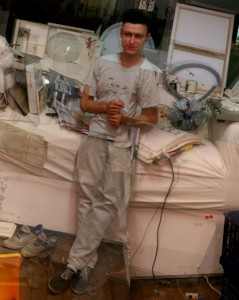
The process by which a group of people come to an idea and then make it into some form of reality is intriguing, and the colour spectrum that we collaboratively composed that afternoon is an occasion for engaging that process. Astrid’s public announcement was the cue for Smith to leave, not becuase he disliked the idea but because it offered a kind of clean break. Whatever it was that had happened until now was ending, and something – whatever that will be – is going to take its place. Moments like these have a sense of definition to them that offers an aid to the indecisive, which we all are more or less, Smith perhaps slightly more. Mum and Dad’s reaction to the sudden implementation of an idea they didn’t quite grasp was to loiter in various parts of the room before relocating to the lounges in the next room. This is an understandable reaction because at this stage there was no sense of how the idea of a room arranged into a colour spectrum was going to work. One makes colour gradients with pixels or paints, not with objects, many of which had different colours. The enthusiasts amongst us – Astrid, Amy, Pat, Tom Spiers & myself – were certainly busying ourselves about the room, we moved the couch into the window and the foosball table to the corner where the couch had been, but none of us had any clear plan – or all us different plans – of what was happening. Tom Spiers, seeing that most of our attempts to unblock the room only blocked it up somewhere else, proposed a bifurcated system with one side stacked and the other side free for passage, but this didn’t help anyone figure out what to move. Designating the coloured areas and the order of the spectrum certainly did help, but our initial burst of largely purposeless activity was giving way to a great deal more standing around and watching one another. At the time I remember grappling with the vision in my mind and the reality of what was in front of me, and wondering whether this idea would turn out to be any good. But retrospectively I see that this slow period was a completely necessary part of the ecology of the event. It is like a series of small waves that precede the bigger set you are waiting to ride, a kind of gathering pause, a breath. I think this is how groups of people naturally make things: there is an initial burst of energy created by the idea, followed by a lull in which the creative forces must negotiate an impossible pact with the complex given reality surrounding them. This negotiation of the impossible is riddled with uncertainty, naturally, since it is entirely possible that an impossible negotiation may not be possible, and activity in this period is largely aimless. But if by some unknown magic a path opens up – and the magic is precisely that unknown that makes something impossible possible – then it’s likely the whole thing will just ignite, without anyone really knowing how, perhaps pausing in the middle of it to realise that shit, something is happening here.

I think one of the things that helped kick-start us was Tom Spiers composing the black corner of the room, using the foosball table, the TV, the aerial, the teak lamp stand, the flat tyre and all the other black paraphernalia. At the same time Amy began to stack the brown chairs and the wood on the sideboard cabinet at sharp angles. They looked almost aggressive set aside the careful black corner of Tom’s. These we timely ludic reminders that the colour spectrum idea was not going to be realised by rigid arrangement, but by imaginative play, by composition. From that point on the level of purposeful activity was steadily rising, and, as if waiting for precisely such a moment, people started arriving left, right and centre. Joel came back happy-as-pie after picking up his new computer. Simon Yates and Vanessa Berry arrived and Vanessa was dressed perfectly for such a colour party (although it must be said she is always a one-woman colour party). Louise Curham and Lucas arrived just after that and suddenly the room was abuzz. Pat and Astrid began arranging the red section at the foot of the black and brown areas while I was sticking the green bits to the opposite wall. The energy in the room was pulsating and it drew my parents out from the next room. Astrid, Mum and Lucas piled the yellow chairs next to the red section and below the brown and I climbed the ladder to swap a section of the fluro lights with red bulbs that had been brought in by a lady called Jo (I think her name was Jo) who lived nearby and having chanced upon the opening night had since visited the space numerous times. Feeding the old white bulbs into the cardboard packaging made this horrific squeaking sound. The colour spectrum composition was really beginning to take shape when Pat used the orange tape as a gradient to connect the chairs from the brown sideboard to the pile of yellow chairs. We put yellow sticker-dots along the tape to further this sense of colour gradient and this was the kind of attention to detail that was now everywhere in the room, no better illustrated than Tom Spiers who gutted the electronics to salvage the coloured wires and then gaffered them on the wall as if to guide the colour spectrum. There was a tremendous sense of joy and achievement now that the idea was close to being realised and every last little object in the room was in some way integrated into its colour area. It was very satisfying to see a room ordered on a principle of colour and we all loitered happily in our little creation. It was decided that for taking a photo we would all have to be seated in colour area corresponding to our clothes and so as Tom Spiers took the photos that would make the panography this is how we were: all blacks Pat and Amy standing together in the black area, Astrid lying on the floor with her bottom half in the black and her top half in the red, Mum with her scarf at the interstice of black, brown and red, Lucas with his brown and yellow wool hidden amongst the chairs and sideboard, the light coloured Joel blended into the white and grays, Dad with his cool blue jumper sitting on the massage table and me with my hoody standing in front of my green wall.
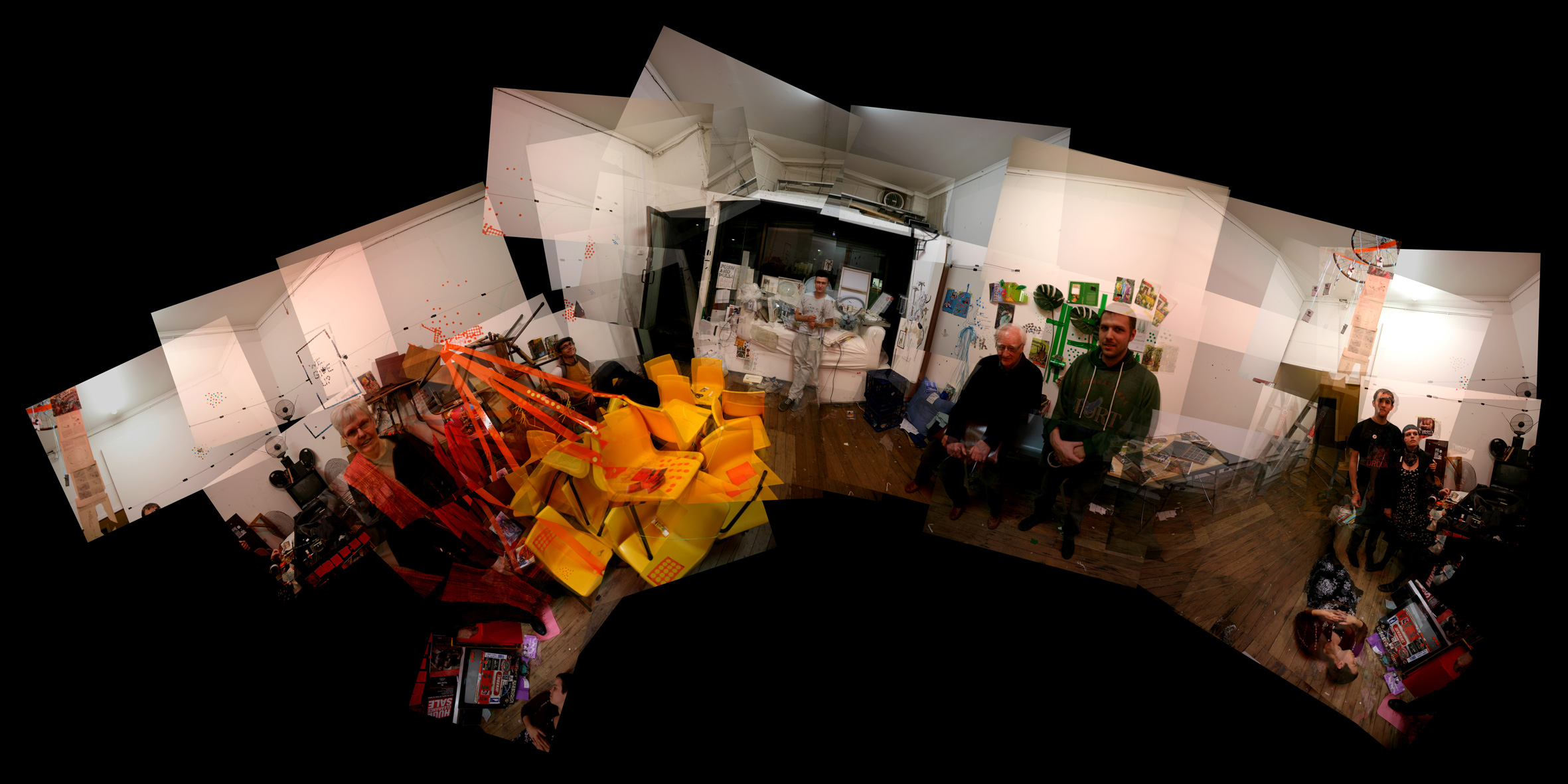
I’m terrified by how god-like Joel appears!
[…] by seeing Pat and Tom’s great panorama, I’d just like to draw attention to Jimmy Nguyen’s autonomous contribution to […]
Are you suggesting Joel’s not a god?
Yes!
We Rule
I love the unraveling of a space away from its human perspective, So many different avenues of space and time refracted together, loverly. Interesting the museum like posing, the reverence given to the camera (all except Joel who was thinking about chai lattes and Wifi).
Lets do a few more